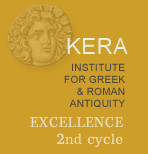Kirazlı Yayla
91. Inscription on a family grave
![]()
5 |
Τὸ μνέ̣̣μα τοῦτο ἐργά– σαντο Ἀχιλλεὺς καὶ Ονοβ– ασις [οἱ] Ὀνεσᾶδος υἱοὶ ἄνδρες εὐδαίμονες ἑαυ– [τοῖς] καὶ γυναιξὶ καὶ ἐγγόνο– ις [– (ca. 5) –] vacat |
This grave the fortunate men Achilleus and Onobasis, sons of Onesas, built for themselves and their wives and their descendants [ ... ]
Inscription on a Lycian type rock-cut tomb, on the upper right side of the wall next to the door. Both the tomb and the inscription appear to belong to the 4th cent. BCE. Naour describes the location of this tomb as "30 minutes walk from the mosque of Deyne in Kirazlı Yayla, 20 km S of Çameli". The small plain of Kirazlı Yayla, ca. 17 km W of Dikmen Tepe, may have belonged to the territory of Boubon, which was the nearest city, and one to which communication was reasonably easy, according to Naour (see the map; cf. Naour, op. cit., pp. 123-124).
Naour 1976, p. 124, no. 15 (drawing); SEG 26 (1976-77), no. 1415.
Letters: ca. 3 cm. Their forms speak for an early date: wide alpha with straight middle line, splayed mu, nu with unequal vertical lines, sigma noted with the same sign as mu.
L. 1 : Epsilon instead of eta in μνῆμα and in Ὀνεσᾶδος (l. 3) seem also to speak for an early date (cf. above).
L. 2-3 : Ἀχιλλεύς is attested in Termessos and elsewhere in Pisidia. It is seldom in Lycia (cf. TAM III 58, Telmessos; 356, Xanthos) and seems to be hitherto unattested in Cibyra. Ονοβασις: because mu and sigma are represented here with the same sign, it would also be possible to read Ονοβαμις. Both names would be previously unknown. Naour prefers to read Ονοβασις in parallel with Λογβασις (TAM III 614, Termessos). One might add Σωσοβασις (Bean and Mitford 1965, p. 30, no. 32, Iotape, Cilicia) and Ουαββασις (Heberdey and Wilhelm 1896, p. 124, no. 201, Dalisandros, Isauria). Ὀνησᾶδος is the genitive of Ὀνησᾶς, a pet-name for Ὀνήσανδρος or Ὀνησαγόρας. Naour, op. cit., p. 125; Robert 1938, pp. 153-154; 182-192; id. 1937, p. 107, no. 2; BullÉp 1972, no. 458.

